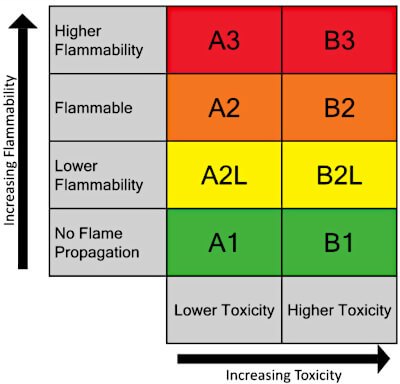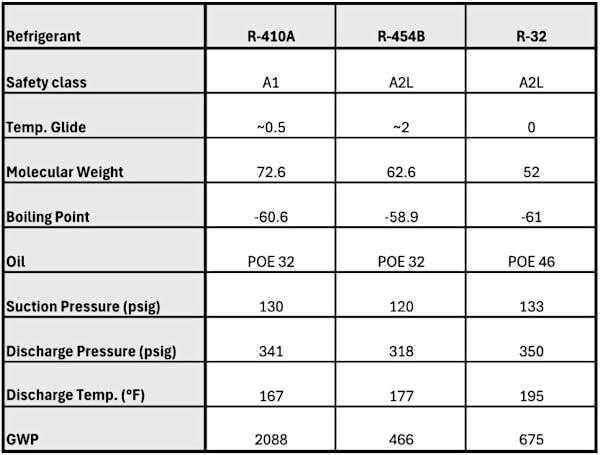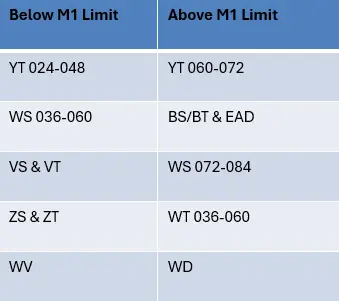ENERTECH’S A2L REFRIGERANT TRANSITION
Change is afoot in the HVAC industry with movement away from ozone-depleting hydrofluorocarbons (HFCs). As of January 1, 2025, new standards for manufacturing with refrigerants have gone into effect. Here’s what HVAC professionals need to know.
Click the video below for an informative webinar from us that provides insight into best practices for the installation and operation of our A2L-compatible equipment
What’s behind this change?
In 2020, Congress passed the American Innovation and Manufacturing (AIM) Act that helps industries transition to
more environmentally friendly refrigerants. The act provides guidelines for phasing out certain refrigerants
considered HFCs.
Every refrigerant carries a global warming potential rating (GWP) that reflects its impact on the environment. The allowable GWP limit for refrigerants in HVAC systems will now be 700.
How does this affect HVAC products?
This change impacts the use of R-410A, previously an industry standard for HVAC refrigerants. With a GWP of 2,088,
R-410A exceeds the new 700 standard. Many manufacturers are transitioning to R-32 or R-454B as replacements for
R-410A. Enertech is transitioning to R-454B as its standard refrigerant.
Getting to know A2L Refrigerants
A classification system identifies a refrigerant’s flammability and toxicity. Class A refrigerants are non-toxic.
Class B refrigerants are toxic.
Both R-454B and R-32 are A2L refrigerants — slightly flammable and non-toxic. By comparison, R-410A is an A1 refrigerant—non-flammable and non-toxic.

The switch to A2L refrigerants brings along some additional requirements that we outline below.
Why R-454B?
While no other refrigerant can serve as a drop-in replacement for R-410A, the R-454B’s temperature and pressures
come close. R-32, on the other hand, has a higher operating pressure as well as a higher global warming potential.

- Enertech has been transitioning its line of products to R-454B refrigerant. Some of our products have already undergone this transition and remaining product lines will be updated as 2025 progresses. Products built before the transition will be available while supplies last, but all equipment manufactured after January 1 will use R-454B refrigerant.
- To help you identify the refrigerant your Enertech equipment uses, the “J” revision will include all Enertech units using the R-454B refrigerant.
- R-410A packaged equipment, or equipment that is factory charged, will still be eligible for sale up to three years after the transition date. This does not include field charged R-410A systems, such as Enertech’s BS/BT split unit line. Unlike packaged units, R-410A systems currently have an installation restriction date of January 1, 2026.
- Enertech equipment that uses A2L refrigerants will be certified to UL60335-2-240. This certification standard regulates the design and testing of electric heat pump products that use A2L refrigerants. As part of this certification, certain equipment and models will include options for refrigerant leak detection systems.
- Some installation procedures that are now considered best practices for working with A1 refrigerants will be
required when working with A2L refrigerants. These include:
- Purging with inert gas
- Evacuating the circuit
- Leak and pressure testing
Familiarity with a few terms can help you navigate news and information about the transition to environmentally friendly refrigerants.
- GWP (Global Warming Potential) – The measure of relative climate impact of greenhouse gases.
- A2L – A class of refrigerants considered non-toxic and mildly flammable.
- A1 – A class of refrigerants considered non-toxic and non-flammable.
- RDS (refrigerant detection system) – This system helps you identify refrigerant leaks.
- HFC (hydrofluorocarbons) – A class of refrigerants that includes R-410A that are considered to negatively impact the atmosphere.
FAQs
Is R-454B a drop-in replacement for R-410A?
No. There is currently no known direct drop-in replacement for R-410A. However, the R-454B’s temperature and
pressures come close.
What is R-454B’s refrigerant blend?
R-454B is a blend of R-32 (68.9%) and R-1234yf (31.1%). This blend helps to create similar characteristics to that
of R-410A, while also providing a 78% reduction in GWP.
Does R-454B have glide?
Yes. Its minimal glide resembles the glide of R-410A.
Can you “top off” systems with R-454B?
Yes, you can top off R-454B systems in the field.
Is R-454B charged the same as R-410A?
Yes, you will charge the system with the service cylinder inverted.
Can I still install R-410A products after January 1, 2025?
Yes. Manufacturers are prohibited from producing equipment using R-410A on or after January 1, 2025. Current regulations
allow the installation of R-410A split systems up to January 1, 2026. R-410A packaged systems, or those where the
refrigerant systems are factory completed, are eligible for sale up to three years after January 1, 2025.
How do I know when a refrigerant detection system (RDS) is required on an installation?
There are several factors that determine whether an RDS will be required for an installation. These include the
refrigerant charge level of the equipment being used and the dimensions of the space where the installation occurs. We recommend
that you also check with your local code officials and governing bodies for specific RDS requirements in your area.
All Enertech equipment over the M1 charge limit, or 62.6 oz of refrigerant charge, will have a factory installed or provided RDS. The chart below details which models fall above and below the M1 charge limit.

Will R-410A replacement components be available?
Yes, R-410A replacement components will continue to be made available for the foreseeable future.
How will this affect the tools I use out in the field?
Certain tools, such as recovery machines, gas detectors, and leak detectors will now need to be A2L certified or
compatible.
How do R-454B refrigerant cylinders differ from R-410A cylinders?
A2L cylinders will have a red band with gray color and left-hand threads. No change on equipment means that an
adapter will be required. Lastly, they now feature a pressure relief valve, as opposed to a rupture disk.
Resources
Additional FAQ’s from the EPA:
https://www.epa.gov/climate-hfcs-reduction/frequent-questions-phasedown-hydrofluorocarbons#OEM-products
A2L Refrigerant Building Code
Map: https://www.ahrinet.org/a2l-refrigerant-building-code-map
AHRI Safe Refrigerant Transition: https://www.ahrinet.org/advocacy/safe-refrigerant-transition
ICC preparing for A2L Refrigerants:
https://www.iccsafe.org/products-and-services/i-codes/a2l-refrigerants-transition/
ACCA A2L Refrigerant Safety Training: https://www.acca.org/education/a2ltraining